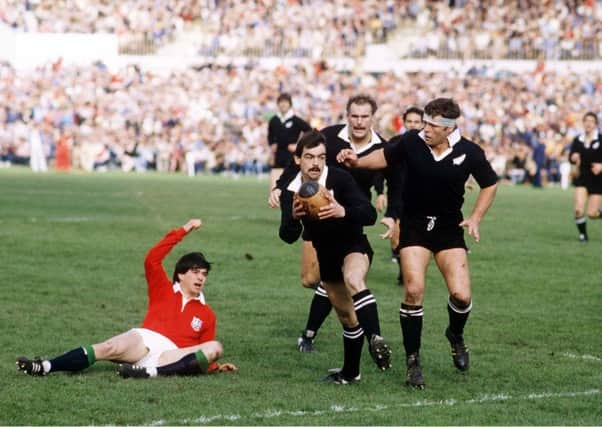Roger Baird feared his Lions cap had been consigned to dustbin


Caps are being awarded for the first time to the 419 living Lions and the next of kin of the 416 deceased men who have represented the combined nations touring squad and Baird knew his was on the way. However, as the former Scotland wing recounts, it was very nearly lost.
“The weekend before last it was delivered,” he explained. “I knew about it and that it was coming but I’d been out with the dogs and got back to find one of those cards through the door.
Advertisement
Hide AdAdvertisement
Hide Ad“So I thought ‘och, it will be at the post office and I’ll get it on Monday morning’. Then when I went on the Monday I looked at the card and discovered it wasn’t at the post office at all, the parcel company note said ‘we’ve left it in a safe place, your green bin’. I knew we had had a bin collection at the end of the week so panicked a bit and hared back to the house to see if the bloody thing was still there!
“Thankfully it was the grey and brown bins that had been collected, not the green one. But it all could have gone horribly wrong.”
Baird was part of the 1983 tour to New Zealand and is thrilled by the Lions’ gesture in recognising all those who have played competitively for the combined side since the first tour in 1888.
“It’s a great statement by the Lions, with the posthumous awards really good too,” said Baird. “I’m number 590 on my cap and we also got a Lions Tales book, team photograph from our specific tour and a letter from [chairman] Tom Grace. It’s really well done.”
Grace, who toured with the Lions in 1974, recently presented the oldest living captain Ronnie Dawson (#388) and the youngest living captain Sam Warburton (#800) with their caps and said: “We felt that in was in keeping with the universally recognised process of acknowledging that someone has played for an international team to formally award Lions caps for the first time. I know I will cherish and keep mine for future generations of my family to enjoy and wonder at.”
In further recognition, Baird’s club Kelso hosted an evening to celebrate their Lions last Friday, with Ken Smith (1959), John Jeffrey (1989), Alan Tait (1997) and Ross Ford (2009) joining Baird at Poynder Park. “It was a great night,” said Baird. “Jim Telfer being there as guest speaker was just fantastic. He was an ever present through my career. Kicked me a lot of times but all for the better.
“Jim made the point how incredible it was for a small town like Kelso to have five Lions. It’s a great privilege to be part of that.
“There is a lot of luck in being a Lion, some great players don’t get the chance, you happen to be playing well and fit at the time of the tour and you get selected.
“You never take these things for granted.
Advertisement
Hide AdAdvertisement
Hide Ad“There was an amazing span of 50 years for us at Kelso, from 1959 with Ken Smith through to 2009 and Fordy.”
The Lions lost 4-0 to the All Blacks in 1983 but Baird’s memories of the tour remain largely positive.
“We lost two of the provincial games against Auckland and Canterbury, and shouldn’t have lost either,” he recalled. “We had the chance to win the first Test and blew that. That would have made a massive difference in terms of momentum. It wasn’t the greatest Lions team that went out there, we were a bit undercooked, and poor Jim Telfer! [who coached the Lions in 1983].
“Even as Scotland coach then he had an assistant in the shape of [the unrelated] Colin Telfer, who was backs coach. But on that Lions tour it was just Jim on his own, which is incredible really. The New Zealanders were light years ahead, they had about ten on their coaching team.”
Baird played in all four Tests and scored six tries in his 11 Lions appearances overall, which was in contrast to a Scotland career which saw no tries in 27 caps.
His most famous try in the 1983 series came in the third Test, with fellow Scot John Rutherford also crossing that day in Dunedin as the Lions outscored the All Blacks two tries to one but still lost 15-8.
“It could have gone better but look, it was still a fantastic tour,” said Baird. “We had our [30-year] reunion in 2013 and just about everybody turned up. It was brilliant. We had great fun. And it was nice to get that try I suppose after my meagre attempts with Scotland.”
Baird is hopeful that Ford, Scotland’s most-capped player, won’t be the last Kelso man to become a British and Irish Lion but admits to pessimism about the direction Scottish club rugby is heading.
Advertisement
Hide AdAdvertisement
Hide Ad“You might [see another Kelso Lion],” said Baird. “He might come from Kelso, coming through the great youth set-up they still have there, but obviously he would need to move on to develop a pro career. And I don’t think you’ll ever see Kelso again challenging for national championships and the like.
“I’m afraid Super 6 is the death knell to a lot of clubs. I’m very much agin it. Semi-professionalism is a tried and failed model in other countries. I think it’s all wrong.”